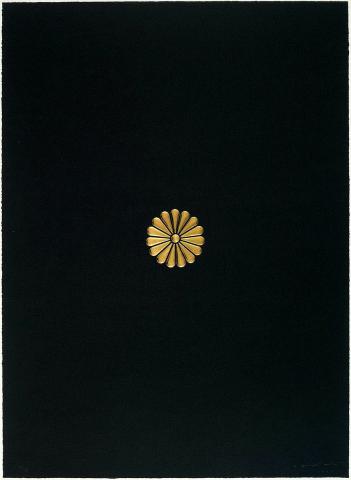ESSAY: Yanagi’s Hinomaru (Rising sun)
By Reuben Keehan
‘We Can Make Another Future’ September 2014
Living in New York in the early 1990s and participating in the ‘Aperto’ exhibition at the 1993 Venice Biennale, Yukinori Yanagi was one of the first emerging artists of the Heisei era to gain widespread international recognition. His iconic Ant Farm installations — composed of grids of national flags in interconnected transparent cases filled with coloured sand, which was gradually eroded and intermingled by colonies of ants — arrived at a moment when globalisation had, for many observers of geopolitics, thrown into question the authority of traditional conceptions of the nation state, along with the myths and ideologies represented by its attendant symbols. At the same time, an upswing in nationalist fervour and ethnic tensions was witnessed around the world, boiling over into genocidal violence in some regions and cynically incorporated into the populist politics of others.
In Japan, the accession in 1989 of the first truly secular emperor in Akihito sharpened debates on the legacy of militarism and the relevance of the peace constitution to Japanese society. In the context of a resurgent nationalism premised on restoring prewar institutions and ethnic homogeneity, Yanagi produced a parallel body of work centring on the Hinomaru, the Japanese flag’s red ‘circle of the sun’ on white ground. His 1991 Hinomaru (Rising sun) (portfolio) consists of a sequence of six lithographs playing on the visual symbolism of the flag and the stylised chrysanthemum of the imperial seal, which features on the Japanese passport. The four central prints of the portfolio present the flag’s red disk as an amalgam of hundreds of inkan or hanko stamps, seals used in place of signatures on official documents, whose size and design can vary according to gender and workplace hierarchy.
It appears, successively, at full scale, overlaid with an off-register blue lobe composed of thumb prints, suggesting a correspondence between the Hinomaru and the Taegeuk at the centre of the South Korean flag, while referencing the mandatory fingerprinting of foreigners in Japan, including those born in Japan to foreign parents. It also appears in a state of eclipse by a similar black disk, and in miniature, reduced in significance. The sequence is bookended by two versions of the chrysanthemum crest: the first elegant, regal, embossed in gold on black; the second on red, dispersed, like petals on the wind, leaving a final petal, which, with its central disk, resembles the exclamation mark of Hi Red Center, the 1960s avant-garde group. Near each petal are the words suki and kirai — love and hate, like and dislike or, more playfully, ‘he loves me’, ‘he loves me not’. With each represented in even numbers, the work gives no clue as to which romantic insight the final petal will reveal.
Like the slow collapse of the flags in Yukinori Yanagi’s Ant Farm works, this image reads not just as a metaphor for the dissolution of social and political structures, but also as an ideal process, an intermingling of peoples and cultures that inures against belligerence and conflict. As the artist noted of PACIFIC – The ant farm project 1996, a grid of 49 flags created for the ‘Second Asia–Pacific Triennial of Contemporary Art’:
It is not necessary to feel sad when you find a symbol of yours deconstructed here in my work Pacific. This deconstruction continues as other recognisable symbols are dismantled too, until a new world — a single new emblem — is introduced.1
Endnote
- Yukinori Yanagi, artist statement, in The Second Asia–Pacific Triennial of Contemporary Art: Artist Statements [exhibition catalogue supplement], Queensland Art Gallery, Brisbane, 1996, unpaginated.
Connected objects
Metadata, copyright and sharing information
About this story
- Subject
